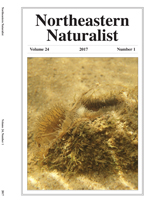Pollen analysis of a 10-m core from the Niles Huyck Bog in Rensselaerville, NY, yields a history of late-glacial and postglacial vegetational change from the beginning of sediment deposition into the bog basin following ice withdrawal to the present. A radio-carbon-dated sequence is provided as time control for the upper 6 m. Late-glacial pollen assemblages seen near the base of the core consist of Abies spp. (fir) and Picea spp. (spruce) as the principal tree genera and grasses and sedges as the main herbaceous components, and resemble pollen assemblages elsewhere in New York and New England. These assemblages were replaced by ones consisting primarily of Pinus spp. (pine), which became dominant ca. 9000 years before present (YBP). By 8000 YBP, pine gave way to Tsuga canadensis (Eastern Hemlock), Quercus spp. (oak), and Fagus grandifolia (American Beech), denoting a more mesic climate. Thereafter, the replacement of oak by beech is a notable trend that continues throughout the pollen profile and is interrupted only by the hemlock decline at 4723 YBP. The pollen spectra then begin to reflect vegetation of a more local character, and ca. 3000 YBP the beginning of the closure of the catchment basin is marked with the sustained increase of Sphagnum spp. (sphagnum) spores. An Ambrosia spp. (ragweed) pollen signal marks European settlement near the top of the core. A pollen signature near the base of the core (Zone H-2) suggests a Younger Dryas (YD; 12,900–11,300 YBP) cooling event for this region, making the sediments below probably equivalent to the Allerød Interstadial for the Niles Huyck Bog. The date for this event is ca. 13,000–14,500 YBP. An estimated date of 14,344 YBP is based on the time needed to accumulate the last 60 cm of sediment and adding it to the end of the YD. This date is in close agreement with the dates recorded for both the nearby Meadowdale Bog and the Great Bear Swamp and supports the hypothesis of a “bottom to top” mode of deglaciation in this region.
How to translate text using browser tools
1 March 2017
Late-Glacial Vegetational History of the Edmund Niles Huyck Bog, Rensselaerville, New York
Ralph Ibe
ACCESS THE FULL ARTICLE

Northeastern Naturalist
Vol. 24 • No. 1
March 2017
Vol. 24 • No. 1
March 2017




